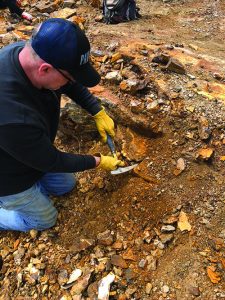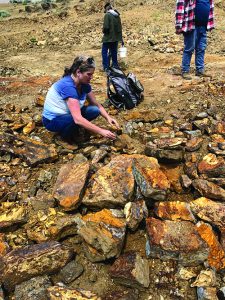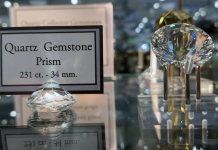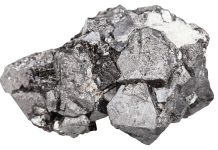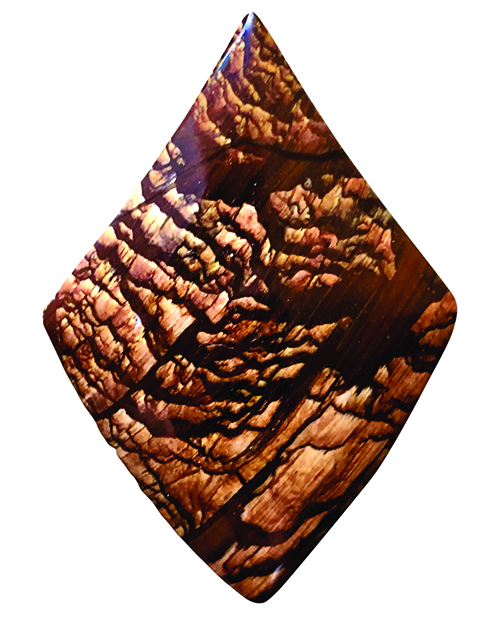
By Bruce McKay
On a nice summer day in 2020, the Thunder Egg Rock Club of Springfield, Oregon, hosted a field trip to Wasco, Oregon, to safely hunt for stones at China Hollow Jaspers’ diggings.
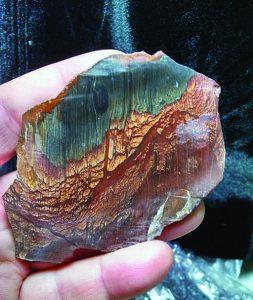
We all met at the China Hollow shop at 1004 Clark Street in downtown Wasco. The group caravanned to the China Hollow dig site, driving across farmers’ fields and down dirt roads. At an elevation of 750 feet in this region runs a layer of jasper, the silicified mud of a long-ago lakebed. Creek gullies cut down to this elevation and the jasper is exposed, bringing delight to rockhounds.
The China Hollow digging has a brown and tan jasper that is a variety of Biggs Jasper. There are various jasper patterns and colors here, with some identified as a type of picture jasper, some dendritic. There are also green and yellow common opal. A 30-foot spire of jasper is what rockhounds first discovered in this area. It was the focus of mining efforts by local Native American tribes for centuries. The spire is long gone, but there was a twelve-foot-tall mass of jasper submerged under the water with just the top showing in a pond at the diggings. There also was a lot of jasper laying around.
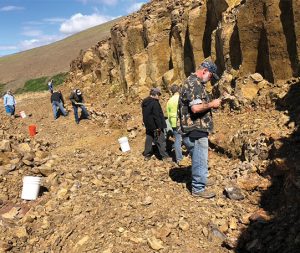
For our next dig destination, the group went a few hundred yards out to a trench where people find agate. The digging there is called the Abo Pit. The upper layers have a peanut-butter-colored jasper, and the lower layers produce a yellow-to-clear translucent agate with peanut-colored spheres or blobs throughout. Some agate appears with yellow plumes, but I did not see any of this come out that day. Our effort was hard rock mining in an exposed trench where the group dug not much agate, but club vice president Steven Barnett hammered and wrestled a 200-pound chunk of solid agate out of the trench wall while the rest of us cheered him on.
After that extraction, we loaded up and drove ten miles to the Beers Mountain diggings to hunt for Biggs jasper. This type is one of the most famous American jaspers, and the chance to dig Biggs jasper is very rare. The site of Beers Mountain also has produced fish fossils, remnants of the old lake bottom. While there, we were asked to turn in any fossils we found as they were not for sale. Our group was one of the first to dig the Beers Mountain Biggs jasper in 30 years.
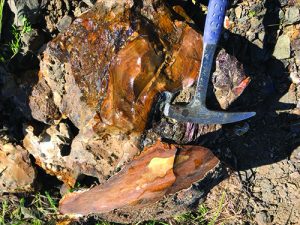
There was a lot of material laying around that had been excavated by the miners. Plus, there was the option to dig into the hill. The digging was very easy as the stone breaks up along seams and comes out in nice thick slabs. We all went to work, quietly digging and sharing our finds, and we all went home with great Biggs rough material. The miners told us that cutting parallel to the slab faces brings out the best patterns, and that worked great with the stones I brought home and cut.
The China Hollow jasper and the Abo Pit agate cost $1 per pound, and the Beers Mountain material is $5 per pound. The dig sites are under different owners, but all of the sites are managed by Jay Carlson. Only groups are allowed in and only by appointment by contacting Jay at: shermancountyrocks@gmail.com or 206-755-6637.
If you enjoyed what you’ve read here we invite you to consider signing up for the FREE Rock & Gem weekly newsletter. Learn more>>>
In addition, we invite you to consider subscribing to Rock & Gem magazine. The cost for a one-year U.S. subscription (12 issues) is $29.95. Learn more >>>


